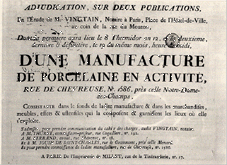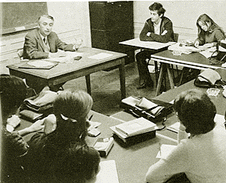

| The Institute for Scholars
at Reid Hall: Historical Background |
|||||||||||
| Columbia University's Institute for Scholars benefits from the Hall's long and distinguished past of intellectual, artistic, and cultural exchange between France and the United States. Indeed, Reid Hall has held a significant place in the relationship between the two countries for well over a century. | |||||||||||
|
|
In
the eighteenth century, what is now Reid Hall was a small porcelain factory.
In 1799, the site—which then consisted of a main building with an entryway
and a garden whose carriage entrance was on rue Notre-Dame-des-Champs,
was rented by the Dagoty brothers. They transformed and enlarged the site, making
it into one of the most successful porcelain factories of its time. |
||||||||||
| By
1812, the main building resembled what exists today: a ground floor, two
upper floors, and an attic lit by ten casement windows which look out onto the
street and ten others which overlook the garden. In the courtyard was the well,
still in existence. |
|||||||||||
| The Dagoty brothers, who employed
over a hundred workers, also built three warehouses and set up four storerooms,
one of which was richly ornamented with mirrors and decorative shelves. Dagoty
porcelain found its way not only to the dining rooms of the local bourgeoisie,
but also to such illustrious residences as the castle of Compiègne, the
palace of Versailles, and the White House in Washington, D.C. The fifth President
of the United States, James Monroe, commissioned a Dagoty china service featuring
a patriotic American eagle motif for use at official state dinners at the Maison
Blanche. |
|||||||||||
| The constellation of buildings
on the rue de Chevreuse, designed for porcelain manufacture, turned out to be
well-suited for educational purposes. In 1834, the site
became the home of the Keller Institute, the first Protestant school established
in France since the revocation of the Edict of Nantes in 1685. Well-to-do French
Protestants and visiting foreigners sent their children to the renowned Institute.
In 1865, for instance, Charles King, President of Columbia College, enrolled his
son there while the family toured Europe. In 1886, the seventeen-year-old André
Gide came to live at the "Pension Keller, rue de Chevreuse," an experience
that he later described in Si Le Grain Ne Meurt. The Keller Institute closed
its doors in 1893. |
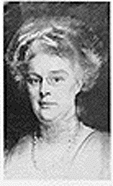 Elizabeth Mills Reid by John Singer Sargent, 1912 |
||||||||||
| The property
then came to the attention of the wealthy philanthropist and social activist Elizabeth
Mills Reid, daughter of the founder of the Bank of California, Darius O.
Mills, and the wife of the American plenipotentiary minister to Paris, Whitelaw
Reid. |
|||||||||||
| Mrs. Reid became interested
in the site on the rue de Chevreuse since she knew of the Keller Institute
and was aware that nearby, on the rue Paul Séjourné, a group
of American men artists lived in a club which enabled them to enjoy the benefits
of Parisian cultural life. Mrs. Reid wanted to make such a cultural sojourn accessible
to young American women artists as well. Thus the "American
Girls Club" was born. |
|||||||||||
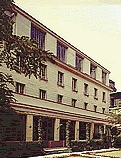 The Institute |
The club was a great success. In 1913, Mrs. Reid bought a neighboring property and constructed the annex, which included seven artist studios looking out onto the garden. This is the building which now houses the Columbia University Institute for Scholars. Mrs. Reid also built the Grande Salle, which is still used for lectures and exhibitions, to link the new and old buildings. | ||||||||||
| During World War I, Mrs. Reid transformed the property into a hospital. The Maison verte, now a classroom, was originally built as a clinic for wounded soldiers. After the Armistice, the site remained in the hands of the American Red Cross until 1922. | 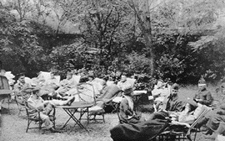 "If I am wounded please send me to Mrs. Reid's Hospital" |
||||||||||
| At that time, a group of American
women, "The Ladies" as Mrs. Reid called them, presented a project to
establish a residential center for university women.
Mrs. Reid's daughter-in-law, Helen Rogers Reid, who was educated at Barnard College
and later became President of the New York Herald Tribune, supported the project.
"The Ladies" who signed the founding agreement with Mrs. Reid included
Helen Rogers Reid, Virginia C. Gildersleeve (Dean
of Barnard College), M. Carey Thomas (founder of
Bryn Mawr College), and three other women educated at Smith, Vassar, and Wellesley.
Dorothy Leet, a graduate of Barnard College, was
named director of the center now called "Reid Hall." |
During
the 1920s and 1930s, Reid Hall welcomed numerous women students, artists,
and professors. The French Association of University Women (AFFDU), which is the
national branch of the International Federation of University Women (FIFDU), became
a member of Reid Hall in 1922. French scholars, civil servants, and intellectuals
came to the Franco-American center to introduce students to the study of French
theater, literature, and art, and to debate major questions in French political
life. |
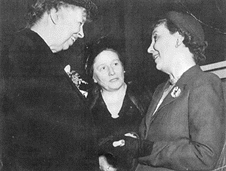 Eleanor Roosevelt, Mamie Eisenhower, and Dorothy Leet |
|||||||||
| Nadia
Boulanger was among these guest lecturers. Rigorous study within Reid Hall
was complemented by the rich cultural atmosphere of Montparnasse. In the 1930s,
the Vavin neighborhood was dominated by four major cafés, Le
Dome, La Rotonde, Le Select, and La Coupole, which were home to an
international and multi-disciplinary group of artists. |
|||||||||||
| This other "School,"
made up of café and artistic society, co-existed with the more traditional
schooling students received at Reid Hall. Yet, sometimes, the two worlds intersected.
For example, in 1931, Gertrude Stein was invited
to the end-of-the-year party by an artist living in one of Reid Hall's studios.
Dorothy Leet reported that "the young students were delighted to have this
opportunity to talk to [Stein]," who had never been formally attached to
Reid Hall. During World War II, the Franco-American center closed its doors and the site became a refuge, first for Polish university women, then for Belgian teachers, and later for the women students of the Ecole Normale Supérieure de Sèvres. After the war, Dorothy Leet, Virginia Gildersleeve, and other long-time friends of Reid Hall took the site back and rebuilt a university center, which now accepted men as well as women students. In 1964, Reid Hall was bequeathed to Columbia University. Several of Columbia's professors, notably Wm. Theodore de Bary, Bert M-P. Leefmans, and Robert O. Paxton, helped with the transition. In 1975, Danielle Haase-Dubosc, educated at Barnard College and Columbia University, became the director. |
|||||||||||
|
|
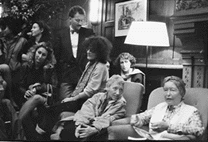 Simone de Beauvoir |
||||||||||
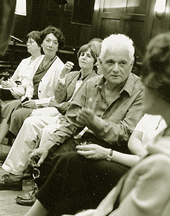 Jacques Derrida |
|||||||||||
| Thanks to the active and enlightened
direction of many women and men, Reid Hall has maintained and developed its educational
and cultural vocation. It welcomes students as well as professors, young scholars
as well as confirmed intellectuals, artists as well as art critics. The spirit
of Reid Hall remains that of sharing, exchange, and the transmission of knowledge.
The Columbia University Institute for Scholars at Reid Hall continues and enhances
this tradition. |
|||||||||||
